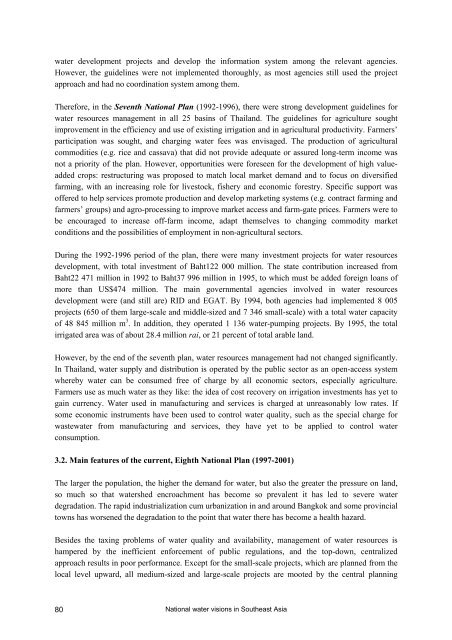The FAO-ESCAP pilot project on national water visions. From vision ...
The FAO-ESCAP pilot project on national water visions. From vision ...
The FAO-ESCAP pilot project on national water visions. From vision ...
Create successful ePaper yourself
Turn your PDF publications into a flip-book with our unique Google optimized e-Paper software.
<strong>water</strong> development <str<strong>on</strong>g>project</str<strong>on</strong>g>s and develop the informati<strong>on</strong> system am<strong>on</strong>g the relevant agencies.<br />
However, the guidelines were not implemented thoroughly, as most agencies still used the <str<strong>on</strong>g>project</str<strong>on</strong>g><br />
approach and had no coordinati<strong>on</strong> system am<strong>on</strong>g them.<br />
<str<strong>on</strong>g>The</str<strong>on</strong>g>refore, in the Seventh Nati<strong>on</strong>al Plan (1992-1996), there were str<strong>on</strong>g development guidelines for<br />
<strong>water</strong> resources management in all 25 basins of Thailand. <str<strong>on</strong>g>The</str<strong>on</strong>g> guidelines for agriculture sought<br />
improvement in the efficiency and use of existing irrigati<strong>on</strong> and in agricultural productivity. Farmers’<br />
participati<strong>on</strong> was sought, and charging <strong>water</strong> fees was envisaged. <str<strong>on</strong>g>The</str<strong>on</strong>g> producti<strong>on</strong> of agricultural<br />
commodities (e.g. rice and cassava) that did not provide adequate or assured l<strong>on</strong>g-term income was<br />
not a priority of the plan. However, opportunities were foreseen for the development of high valueadded<br />
crops: restructuring was proposed to match local market demand and to focus <strong>on</strong> diversified<br />
farming, with an increasing role for livestock, fishery and ec<strong>on</strong>omic forestry. Specific support was<br />
offered to help services promote producti<strong>on</strong> and develop marketing systems (e.g. c<strong>on</strong>tract farming and<br />
farmers’ groups) and agro-processing to improve market access and farm-gate prices. Farmers were to<br />
be encouraged to increase off-farm income, adapt themselves to changing commodity market<br />
c<strong>on</strong>diti<strong>on</strong>s and the possibilities of employment in n<strong>on</strong>-agricultural sectors.<br />
During the 1992-1996 period of the plan, there were many investment <str<strong>on</strong>g>project</str<strong>on</strong>g>s for <strong>water</strong> resources<br />
development, with total investment of Baht122 000 milli<strong>on</strong>. <str<strong>on</strong>g>The</str<strong>on</strong>g> state c<strong>on</strong>tributi<strong>on</strong> increased from<br />
Baht22 471 milli<strong>on</strong> in 1992 to Baht37 996 milli<strong>on</strong> in 1995, to which must be added foreign loans of<br />
more than US$474 milli<strong>on</strong>. <str<strong>on</strong>g>The</str<strong>on</strong>g> main governmental agencies involved in <strong>water</strong> resources<br />
development were (and still are) RID and EGAT. By 1994, both agencies had implemented 8 005<br />
<str<strong>on</strong>g>project</str<strong>on</strong>g>s (650 of them large-scale and middle-sized and 7 346 small-scale) with a total <strong>water</strong> capacity<br />
of 48 845 milli<strong>on</strong> m 3 . In additi<strong>on</strong>, they operated 1 136 <strong>water</strong>-pumping <str<strong>on</strong>g>project</str<strong>on</strong>g>s. By 1995, the total<br />
irrigated area was of about 28.4 milli<strong>on</strong> rai, or 21 percent of total arable land.<br />
However, by the end of the seventh plan, <strong>water</strong> resources management had not changed significantly.<br />
In Thailand, <strong>water</strong> supply and distributi<strong>on</strong> is operated by the public sector as an open-access system<br />
whereby <strong>water</strong> can be c<strong>on</strong>sumed free of charge by all ec<strong>on</strong>omic sectors, especially agriculture.<br />
Farmers use as much <strong>water</strong> as they like: the idea of cost recovery <strong>on</strong> irrigati<strong>on</strong> investments has yet to<br />
gain currency. Water used in manufacturing and services is charged at unreas<strong>on</strong>ably low rates. If<br />
some ec<strong>on</strong>omic instruments have been used to c<strong>on</strong>trol <strong>water</strong> quality, such as the special charge for<br />
waste<strong>water</strong> from manufacturing and services, they have yet to be applied to c<strong>on</strong>trol <strong>water</strong><br />
c<strong>on</strong>sumpti<strong>on</strong>.<br />
3.2. Main features of the current, Eighth Nati<strong>on</strong>al Plan (1997-2001)<br />
<str<strong>on</strong>g>The</str<strong>on</strong>g> larger the populati<strong>on</strong>, the higher the demand for <strong>water</strong>, but also the greater the pressure <strong>on</strong> land,<br />
so much so that <strong>water</strong>shed encroachment has become so prevalent it has led to severe <strong>water</strong><br />
degradati<strong>on</strong>. <str<strong>on</strong>g>The</str<strong>on</strong>g> rapid industrializati<strong>on</strong> cum urbanizati<strong>on</strong> in and around Bangkok and some provincial<br />
towns has worsened the degradati<strong>on</strong> to the point that <strong>water</strong> there has become a health hazard.<br />
Besides the taxing problems of <strong>water</strong> quality and availability, management of <strong>water</strong> resources is<br />
hampered by the inefficient enforcement of public regulati<strong>on</strong>s, and the top-down, centralized<br />
approach results in poor performance. Except for the small-scale <str<strong>on</strong>g>project</str<strong>on</strong>g>s, which are planned from the<br />
local level upward, all medium-sized and large-scale <str<strong>on</strong>g>project</str<strong>on</strong>g>s are mooted by the central planning<br />
80<br />
Nati<strong>on</strong>al <strong>water</strong> visi<strong>on</strong>s in Southeast Asia
















